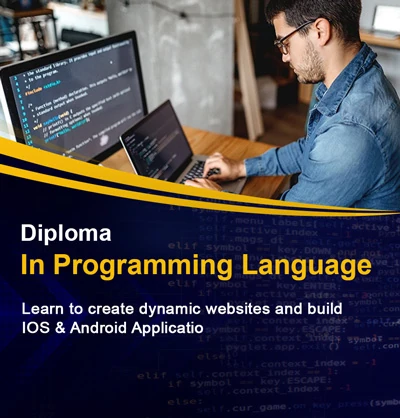C Programming Course
C language is a powerful multi-purpose programming language. It is one of the foundational languages of all programming languages. C programming is the best language to... read more


About Courses
A diploma in programming course is a combination of different programming languages and ethical hacking. This course will teach the essential concepts and coding skills needed for Front-end, Back-end web development, Machine Learning, IOS, Android Development, and much more. It will also teach you about the basic concept of cyber security and ethical hacking, penetration testing and system hacking. DIP course enables you to become skillful in the IT sector by getting in-depth knowledge of IT tools or Web Development.
Course Highlights
1. |
Build dynamic and static websites |
2. |
Ethical Hacking with penetration testing |
3. |
In-depth knowledge of IT tools |
4. |
Developing android apps and software |
5. |
10+ Assignment |
6. |
5+ Live Projects |
7. |
12 Modules |
8. |
1 Year Free Backup Classes |


Learning Outcome
| • | You’ll be able to create websites and android apps. |
| • | You’ll be able to do efficient and effective work by using IT tools. |
| • | You’ll be able to optimize the web pages. |
| • | You’ll be able to Incorporate and examine information, process, and codes to investigate issues and recognize regions for development. |
| • | You will able to form various cryptographic techniques, their pragmatic relevance & weaknesses. |
| • | You’ll be able to build highly available and scalable internet applications. |
| • | You’ll be able to develop fast apps on any platforms. |
Language and tools that you will learn in this course

.webp)
.webp)





Course Content
Jobs You will Get After Completing Course
Programming is one of the most demanding fields in this digital era, There are millions of companies that need a developer to build their website, apps, and software within a time and secure their websites from hackers and much more. This course helps you to become skillful in this developing field and opens up multiple career opportunities after doing this course.
| Job profile After completing this course |
Average salary ( 1+ year experience) |
|---|---|
| Front-End Developer | 25k-50k |
| Back-End Developer | 35k- 70k |
| App Developer | 46k-55k |
| Software Developer | 41k- 100k |
| Ethical hacker | 41k- 50k |
| Full stack Developer | 50k-100k |

Backup Class

Flexible Timing

Fees Installment

Expert Trainer

100% job assistance

Free Library
.webp)
Live Project
.webp)
Practical learning

2.5k +
Student

10k +
Trained

65+
Courses

130+
Batches
Frequently Asked Questions
Candidates must pass Class 10 with a minimum of 45% and more from a recognized board.
Yes, working as a Back End Developer is a smart choice. The Back End Developer's salary is very high. You will get a desirable position with decent compensation and daily learning opportunities.
Yes! Coding can be a good career for many professionals. Programmers or developers get higher salary packages, work flexibility and get various job opportunities in the IT sector.
Programming is a bit difficult but will be done easily with the help of our well-experienced experts and with you little effort.
Max Computer has emerged as the most encouraging & favorable institute in Borivali, Kandivali, Gorai, Dahisar, Charkop which is an ISO certified computer training institute ,started in the year of 2014. We provide various Govt. and Non Govt. Courses to all the desired students.
Yes we provide weekly classes or you can schedule your class according to your suitable time. We also provide online and backup classes so you can attend your missed or pending lectures
.webp)
.webp)
.webp)
.webp)




Get free counselling by our experience counsellors. We offer you free demo & trial classes to evaluate your eligibilty for the couurse.
Have you
Any question
Or need some help?
Please fill out the form below with your enquiry, and we will respond you as soon as possible.